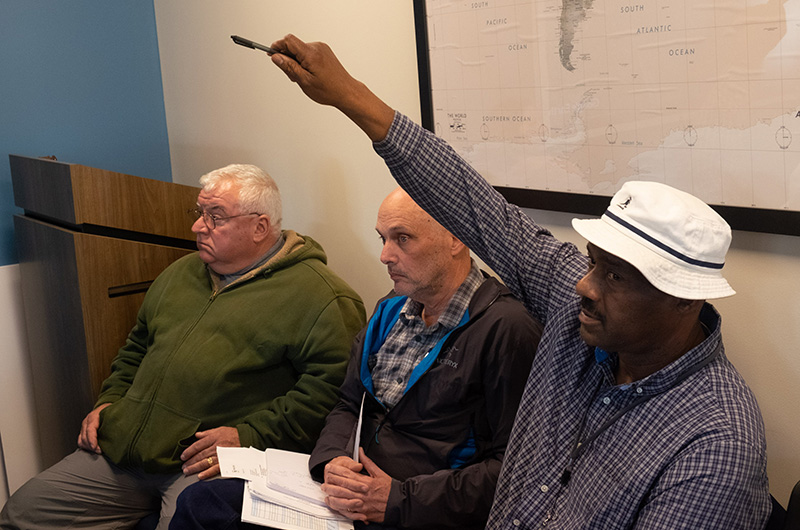At a packed meeting Monday, leaders at the Martha’s Vineyard Airport and their environmental consultant fielded questions and sought to allay concerns among residents following the disclosure last week that chemical contaminants had been detected in a handful of private wells.

The source of the contamination is likely firefighting foam that has released chemicals into the groundwater — a relatively new discovery, airport officials have confirmed.
Used for decades at military bases and airports, including the Vineyard airport, the foam has come under renewed scrutiny since a draft federal study published in June found that two toxic chemicals in the foam pose health risks. The chemicals, Per and Polyfluoroalkyl (PFAS) substances, have been found in drinking water systems nationwide, including private wells near airports.
“This particular issue is turning the environmental world upside down,” Ron Myrick, an environmental consultant and director of remediation for Tetra Tech, told the room full of concerned residents and health officials Monday. “Regulators are trying to figure out what do with this.”
There are no federal standards yet for safe levels of PFAS, but in guidelines issued in June, the Massachusetts Department of Environmental Protection said exposure to elevated levels of the chemical can cause liver, kidney and immune system problems and could be unsafe for women who are pregnant.
Airport officials first reported last Friday that bottled water was being provided to some West Tisbury residents as a precaution after PFAS were detected in groundwater around the airport.
On Monday, Mr. Myrick said well sampling by Tetra Tech began in July in wells on airport property. Those tests found concentrations of over 1,000 parts per trillion, far above safe guidelines of 70 parts per trillion as set by the DEP. Starting a few weeks ago, Mr. Myrick said testing began in residential areas south of the airport, in the down-gradient direction of groundwater flow. He said more than 130 West Tisbury residents living south of the airport were subsequently informed about the findings in letters hand delivered to homes last week.
He said as of Monday, 17 wells have been tested. Four homes are receiving bottled water after wells tested above safe limits for PFAS concentrations. He said more tests are ongoing, and that results take about a week to come back from the testing facility in Mansfield.
“It’s a bigger issue in areas where you have private wells and sand aquifers,” Mr. Myrick said, describing the hydrogeology of the entire area that runs from the state forest down to the south shore. “We’re trying to get as many people out there to understand this problem and what we’re dealing with as possible.”
Edgartown health agent Matt Poole said testing south of the airport could be missing other homes potentially in the groundwater flow.
“A decade of looking at directional movement is more easterly,” Mr. Poole said. He requested that Mr. Myrick begin testing wells east of the airport when time allows.
About 30 residents who crowded the small meeting room in the airport firefighting and rescue building peppered Mr. Myrick with questions.
One asked how the hazardous firefighting foam is contained after it is used for testing at the airport, as required by the Federal Aviation Administration.
“What do you do with all of the captured material?” asked Domingo Pagan.
“We’ve dedicated a 5,000-gallon tank where we can divert the flow of water and all testing is done over that drain,” replied assistant airport director Geoffrey Freeman. “It’s being stored until we can find a facility for removal and disposal.”
West Tisbury health agent Omar Johnson said he had received a deluge of phone calls since the contamination was first reported last week, and asked whether the airport will cover the cost of private well testing.
“I’m being bombarded with questions by residents,” Mr. Johnson said.
“We’re not covering the cost of people testing their own well,” airport director Ann Richart replied. “We’re testing wells ourselves. We’ve identified ones that we think are strategic and important to test . . . as people have requested that we test their wells, if it seems like that’s reasonable, we’re testing them.”

Robert Tonti, who lives in a residential area south of the airport, asked how much impact the foam has had on the groundwater since it was first put into use in the mid-1990s.
Mr. Myrick was frank in his reply. “We just don’t know,” he said “We don’t know how much, and where the problem is yet.”
Ms. Richart said airport managers have made changes in the testing procedures for the firefighting foam since they became aware of the matter last January.
She emphasized that PFAS in firefighting foam and groundwater is a relatively new issue, and said the airport is actively taking precautionary steps.
“MassDEP is using us as a test case for recommendations to give to other airports,” Ms. Richart said. “We’re one of the first being proactive to figuring out what the issue is and how to respond.”
Federal lawmakers responded to the firefighting foam concerns in October by passing a House FAA airport reauthorization bill with a provision giving airports the option to phase out the use of foam with PFAS chemicals in the next two years. Two bills were also introduced with the goal of strengthening federal and state responses to PFAS contamination.
The Vineyard is a sole source aquifer. The Island’s main aquifer covers more than 40 square miles in the center of the Island and supplies about a billion gallons of water annually to Edgartown, Oak Bluffs, Vineyard Haven and parts of West Tisbury and Chilmark, according to an in-depth story about the Island groundwater supply in the December issue of the Martha’s Vineyard Magazine.
Mr. Myrick said Tetra Tech will submit its findings to the DEP by the end of January.
Ms. Richart said when results are known, another public meeting will be held.








Comments (7)
Comments
Comment policy »